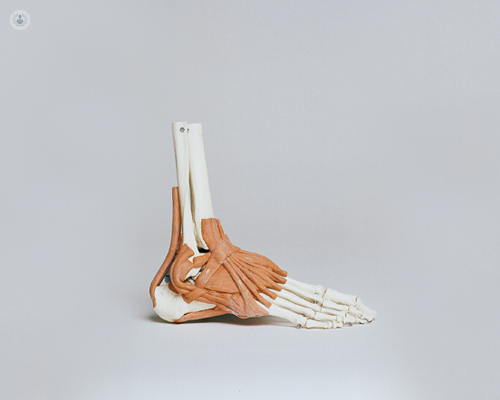Ankle arthritis treatment in-depth
Escrito por:Ankle arthritis can be treated non-surgically as well as surgically. Find out more these methods of treatment, and further details about the condition with Professor Bal Dhinsa, accomplished consultant orthopaedic surgeon in Kent and London.

What is ankle arthritis, and what are its common causes?
Primary ankle arthritis is rare, with arthritis in this joint usually secondary to trauma or inflammatory arthropathy.
What are the typical symptoms of ankle arthritis, and how is it diagnosed?
Pain, swelling and stiffness are common complaints, particularly when walking for long distances or on uneven ground. As the arthritis progresses there may be significant deformity present which makes finding appropriate footwear a challenge and often uncomfortable.
Diagnosis is made with clinical examination, imaging modalities and sometimes blood tests (particular for inflammatory arthropathy).
What are the available treatment options for ankle arthritis, both non-surgical and surgical?
Non-surgical management
In the early stages of the condition, analgesics, non-steroidal anti-inflammatory medication and support with an ankle brace may be of help. As the condition progresses an intra-articular injection with corticosteroid or a viscosupplement can be used for temporary relief.
Surgical management
If there is a mechanical block to ankle movements from bone spurs (osteophytes) and the rest of the joint is well preserved, these osteophytes can be removed through keyhole (arthroscopic) or open surgery.
With advanced arthritic changes, the surgical options are either an ankle fusion or ankle replacement. The fusion tends to be preferred for younger and more active patients as the results are more predictable in this population. Fusion can be performed either with arthroscopic or open surgery and involves the removal of the remaining cartilage and unhealthy bone from the joint surfaces. Once the surfaces are prepared satisfactorily, the surfaces are brought together and held in place with screws or a plate. This stiffens the joint however there will be no pain, and the subsequent limp is subtle.
An ankle replacement preserves some motion in the ankle joint by replacing the worn cartilage on the joint surfaces with a metal prothesis, and there is a plastic insert between the two metal components. With preservation of joint motion there is less transferred stress to the other joints of the foot. Unfortunately, with excessive use they can wear and may need revision which can be a complicated procedure.
What lifestyle modifications can help individuals with ankle arthritis improve their quality of life?
Simple measures such as:
- footwear modification;
- weight loss,
- range of motion exercises;
as well as strengthening exercises, can be of help.
Are there any advancements in medical research or technology that offer hope for ankle arthritis patients in the future?
There is ongoing research investigating the role of stem cell therapy, however no convincing results yet. As a professor of regenerative orthopaedics, I regularly review literature, am critically appraising the publications, and remain up to date.
If you require surgery for ankle arthritis, or would like to find out more, arrange a consultation with Professor Dhinsa via his Top Doctors profile.


